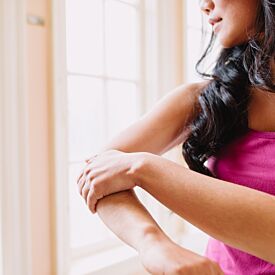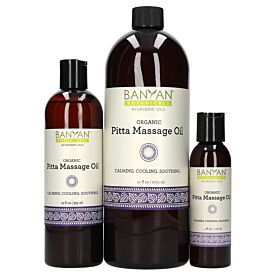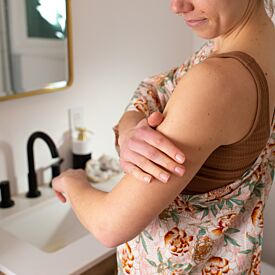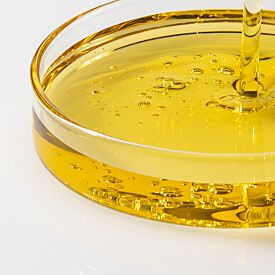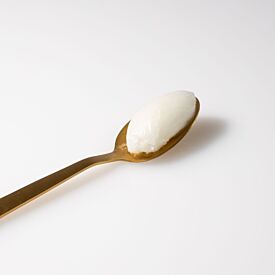Birthing Ayurveda: Postpartum Part 7—Baby Skin and Rashes
Welcome to our Birthing Ayurveda Postpartum series, where we follow the developing story of one woman's first steps into motherhood and life in her new role.
Stroking my baby’s soft cheeks, feet, and her soft hair is one of the most soothing and precious things to me. Not too long ago, however, her cheeks were not the softest things in the world. She had a pretty bad case of baby acne, confirmed by her pediatrician.
In Ayurveda we recognize skin issues as a manifestation of imbalances of the blood tissue (rakta dhatu). The baby’s body is changing so quickly that it is not uncommon for there to be vata imbalances. If breastfed, the baby is also getting plenty of hormones from the mother, a form of agni and pitta, which can also turn into ama (toxins) if not processed properly. Like the mother, there is a natural cleansing of the organs and fluids in the baby that happens right after delivery.
Further, the skin of the baby is very immature for the first several months. It is use to being soaked in amniotic fluid. The skin goes from that environment to a dry environment, where it comes in contact with clothing, bedding, urine (which has a different composition than the baby’s urine in the womb), and feces.

Knowing this, I took good care of my daughter’s skin Ayurvedically.
- I gave her an oil massage daily in the morning. I used plain sesame oil and then started to use Ashwagandha Bala Oil for the strengthening benefits of those herbs. When she was having skin issues, I favored more pitta-pacifying oils like coconut oil and Pitta Massage Oil.
- I didn’t use soap. My mother made a natural cleanser that is great for skin (for adults and babies, alike) out of a tablespoon of chickpea flour, a pinch of turmeric, a teaspoon of sesame oil, and a tablespoon of milk. The chickpea flour exfoliates, the turmeric cleanses and helps with complexion, and the oil and milk nourishes and offsets the drying quality of the chickpea flour. When giving her a bath after her oil massage, I rubbed this over her face and body and rinsed off with warm water.
- I used organic and natural laundry detergent to avoid harsh chemicals coming in contact with her skin.
- I wiped her bottom with baby wipes made from natural ingredients or, more preferably, wipes with plain water. If she had a bowel movement I took her to the sink and rinsed her off with water. Wipes do not clear off all residue which you can see if you go back and wipe again at a later time.
- She spent some time every day without a diaper. After she was several weeks old, we let her bath in the sun without a diaper, allowing her bottom to get some fresh air and oxygen.
Still, quite naturally, we encountered some skin challenges.
- Diaper rash. If you use diapers, you are sure to get a diaper rash one day or another. We have had only a couple of mild cases of diaper rash. I believe the above measures help as does inspecting my baby’s bottom every time I change her diaper. I also learned to not be stingy with diapers, though it broke my heart to think of how much trash we were creating. But after one case of a diaper rash, you will do what you can to prevent it from happening again. At the onset of any redness or bumps, I immediately put on a mixture of ghee and castor oil in one case and a touch of Soothing Skin Balm in another. Both worked wonderfully. I kept her diaper free as much as possible that day and let her bottom soak in the sun. Any time she urinated or had a bowel movement, I rinsed her bottom off with water and reapplied the oils or balm. When she started sleeping longer at night, I preventatively put some ghee and a touch of Soothing Skin Balm on her bottom with her last diaper change. I noticed that she would get the rash when I had a slice of pizza (pitta from onions and tomatoes) or had a lot of heating spices. Think about what you eat and whether it is contributing. For bad cases, think about a yeast infection or food intolerances.
- Baby acne. This is not uncommon. It often occurs after the first few weeks of life and can last several weeks to a month or two. It does eventually go away, though. My daughter had a bad case of baby acne. We tried putting coconut oil and also Soothing Skin Balm on it, cutting out most of the heating spices, including the ladoos (see Part 1), and she still had it. It just took time, though the oils and balm did help ease it. I also noticed that there was a dry component to the acne, making it appear almost like a rash. Even after the redness went away, there was still a subtle coarseness. This indicated dryness and vata. For that, I increased my ghee intake and took a spoonful of ghee after every meal in addition to first thing in the morning.
- Dandruff/Cradle Cap. Like dandruff in adults, the theory is that cradle cap occurs because of excess oil on the skin, to which dead skin cells attach. Many recommend shampooing regularly for that reason. Some say it may be because of a type of yeast infection (I did notice it was worse when she had thrush), especially if there is redness. And then there are those that think it is because of hormones from the mother. Regardless, my daughter’s case of cradle cap responded really well to lightly shampooing every other day or so (so that there is just a little bit of oil left behind from the massage) and putting on a light layer of coconut oil afterwards. You can also consider olive oil. Later in the day, I took a soft toothbrush and gently exfoliated off some of the extra skin cells. In any case, like most skin conditions, this too will likely resolve on its own without much intervention. Time and patience heal so much!
DISCLAIMER
The views and opinions expressed in this article do not necessarily reflect the views and opinions of Banyan Botanicals. Our blog is a place where people who participate in and benefit from Ayurveda can share their experience and knowledge. Before starting any new activity, routine, or program, we recommend that you consult with your physician or healthcare provider. Please also note that our content is not meant to be a substitute for professional advice.






